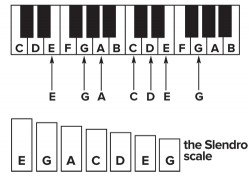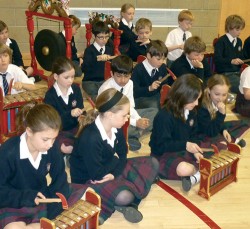Today you will…
...Learn
• To play an authentic indonesian gamelan tune
• To play some music in a cyclic pattern
• To understand a pentatonic scale
• And to play together as a group
Sir Frances Drake, who sailed around Java in the year 1580, on hearing Gamelan music for the first time spoke of a music that was “very strange, pleasant and delightful” and this is certainly still true today.
A Gamelan is a collection of gongs, metallophones and drums, supplemented with some string and wind instruments, all originating in SE Asia. The Gamelan sound, like the Indonesian culture it comes from, is vibrant, colourful and exotic. The music is cyclic, built up from relatively simple repeated patterns, making it easy to teach and to learn.
The word Gamelan comes from the Javanese word ‘Gamel’, which means hammer. Most of the instruments in a traditional Gamelan orchestra are percussion instruments, which is to say they are played by striking, either with a stick or mallet (hence the hammer), or with the hand.
Gamelan playing encourages careful listening, self-confidence and teamwork. It’s also a very visual experience as well as an aurally and culturally rich one – and an end of term performance can be thoroughly spectacular.
Although traditionally very bulky and expensive, Gamelan can now be successfully taught in regular weekly lessons in schools using smaller and affordable ‘chamber Gamelan’. A chamber Gamelan can either be put together in-house using modified school tuned percussion instruments, such as glockenspiels, which are readily available in most music class rooms, or they can be purchased from specialist world musical instruments makers.
Drums for Schools now imports a range of genuine Gamelan instruments, all made in Bali and the company also supplies starter packs costing just a few hundred pounds.
Starter activity
Create a Gamelan scale
To create most western music, we use what is known as a chromatic scale and it contains 12 different notes. However, many non-western traditions use a pentatonic scale, made up of just five different notes, and this is much more user friendly and does not lend itself to accidentally playing ‘wrong’ notes.
We will use a five-note or pentatonic scale to play our Gamelan music, using the western notes G, A, C, D and E. The lowest note G will be reproduced an octave higher as the top note in our scale and the highest note of our five note scale, E, will also be reproduced an octave lower two notes below the first note G to become the lowest note of our scale. Together these notes produce the seven note Slendro scale:
E, G, A, C, D, E, G. On a keyboard or tuned percussion instrument find the notes G, A, C, D and A in ascending order. If you have a keyboard you can mark the notes with a coloured sticker or if you have tuned percussion instruments with removable keys, you can take off the notes you are not using and put the remaining notes next to each other in ascending order.
Next you will need to find the note that is an octave higher than the lowest note G and either mark this or place it at the top right hand end of your other notes. Then find the note that is an octave lower than highest note E and mark or place this note at the bottom of the row of notes on the left hand end of the instrument. This will create the seven-note Slendro scale. You should now have a keyboard or tuned percussion instrument that looks like this:

Main Activities
1. Saron
Using the grid notation below, we will begin to play our Gamelan tune. The shaded area at the top of the grid represents the beat numbers and our tune will repeat slowly round and round, from beat 1 through to beat 16, and then straight back to beat 1 again, to produce our cyclic pattern. Ask your pupils to play the note written under each beat number. The lower octave E will be written with a downward pointing arrow ? and the higher octave G with an upward pointing arrow ?. The other notes will be part of the five note pentatonic scale. The name of the Gamelan instrument that plays the main theme is called a Saron.
Remember to start slowly and to learn the tune in small sections of four beats at a time.

2. Demung
Now you can add a second part that plays a shortened, ‘skeletal’ version of the melody. The letter O is a rest, when no note is played. This part can be played on lower sounding tuned percussion or an octave lower on the keyboard. This part is played by an instrument known as a Demung.

3. Gongs
The last part we are going to add is traditionally played by three gongs but if you do not have gongs, three differently sized cymbals (small S, medium M and large L), played with a soft beater will suffice. The gongs play at the end of musical phrases, giving the characteristic ‘end-weighted’ feel of Gamelan music.


4. The grand performance!
This is the thrilling culmination – your whole class can now combine all three musical activities into your own performance. Start slowly, playing just the Saron and Gong parts, then add in the Demung part and begin to gradually speed up. You may want to add a drum to keep the tempo. When the group has reached its maximum speed, suddenly slow down for one more cycle, before ending with a solo note on the large gong or cymbal.
Home learning
In this homework students should be asked to investigate the many different ways in which the Balinese use gamelan music. They should find that the music has a role in religious ceremonies, in weddings and in celebrations; that it’s used to accompany dances and plays and that it’s also used for processions and as background music. Almost every village has its own gamelan orchestra and bigger towns will have dozens of them. The players are all volunteers and every year the best orchestras play in the Bali Arts Festival.
Summary
Ask the pupils about the sound of the music and how it makes them feel. Look at some performances of Gamelan from the internet. How do the musicians work together? A more detailed description of Gamelan music and how to incorporate it into your lessons can be found in my Indonesian Gamelan Book.
Info Bar
Additional resources
Drake’s voyages and historic documents: tinyurl.com/yg2m85h
Balinese Gamelan performances: tinyurl.com/9h3unqp
About the expert
Andy Gleadhill has over thirty years experience as a professional musician and teacher. He regularly delivers lectures to music, arts and educational conferences around the world. Currently the Head of Bristol Arts and Music Service and Director of the Bristol Centre for Music and the Arts UK, he is the author of the acclaimed World- Class Music Teaching Guides.
Andy’s Indonesian Gamelan book is available now from www.drumsforschools.co.uk or visit www.andygleadhill.com









